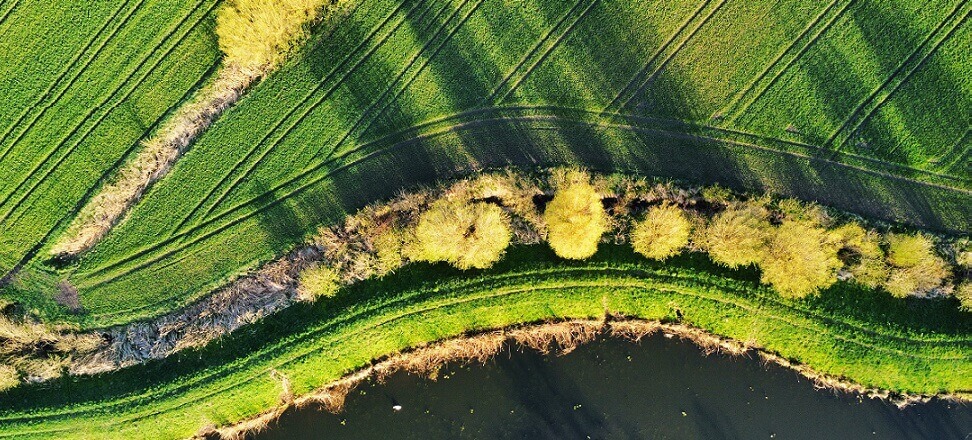Soil is a key, non-renewable and irreplaceable resource. Its good condition is essential for the development of the economy and a safe society and environment. Soils play an important role in the cycling of nutrients, carbon and water. In turn, the adequate availability of water in the soil determines the proper development of plants and their resistance to drought.
Soil-water relationship, or the importance of soil retention
The soil’s ability to retain water, and therefore soil retention, helps prevent and respond to natural disaster risks. The soil’s ability to retain water from precipitation reduces the intensity of flooding and mitigates the negative effects of water shortages and drought. Healthy soils with functional retention capacity also support healthy forest ecosystems, which make them more resilient to wildfires – a growing challenge with climate change. Soil is also a core value in the broader agricultural sector, and its condition affects not only food security and agricultural productivity, but also the sector’s resilience to climate change.
Soil water source or lack thereof
Sources of water in the soil are precipitation, water underflow from deeper soil layers, condensation or artificial irrigation. On the other hand, water losses in soils are due to surface and subsurface runoff, seepage of water into deeper layers, and evapotranspiration – that is, evaporation of water from the soil surface and plants.
Soils and soil retention – role
Soil retention is assumed to be the space where stored soil water occurs in the unsaturated zone of the soil profile, above the water table. Its size depends on the type, mechanical composition and structure of the soil. The availability of healthy, fertile and adequately hydrated soils is crucial to the transition to a sustainable bioeconomy. Soil retention and maintaining soil health is of great importance to both farmers and society as a whole. It contributes to stable, sustained high yields, thereby ensuring long-term production security and business prospects for farmers, and food security for society.
Land degradation, on the other hand, harms not only agriculture but also human health. Persistent particulate matter in the air, created by wind erosion, causes or exacerbates respiratory and cardiovascular diseases. Sealed soils make it more difficult for temperatures to drop during heat waves and have less capacity to absorb pollutants. In addition, some soils in the humus level contain concentrations of cadmium that exceed the limit for groundwater – thus, they can cause water pollution.
Soil condition
According to the diagnosis provided by the EC in its proposal SWD(2023) 418 final, the state of approx. 60-70 percent. soils in the European Union cannot be considered good, and the problem of degradation exists in all member countries. It is estimated that 61-73 percent. EU agricultural soils are affected by erosion, loss of organic carbon, nutrient overruns, compaction or secondary salinization. In Poland, approx. 36 percent. Arable land is in poor condition due to erosion caused by water, wind, plowing and cultivation. It is estimated that approx. 58 percent. arable land and permanent grassland is in poor condition due to low organic carbon content, and that approx. 87 percent. Poland’s peatlands are being destroyed by either draining them or converting them to agricultural land.
Declining soil retention is the result of all these adverse developments. Europe’s resilience to climate change therefore depends on the ability of soils to retain and filter water, the level of organic matter, fertility and resistance to erosion. The soil’s ability to retain water helps prevent and respond to natural disaster risks. When soils can absorb more precipitation, the intensity of flooding decreases and mitigates the negative effects of periods of drought.
Agricultural practices to promote soil retention
Methods to increase soil water resources:
- Reducing evaporation from the soil surface;
- Reducing surface runoff through the use of anti-erosion treatments and intercropping;
- Increasing groundwater recharge;
- Reducing plant evapotranspiration through proper plant selection and proper crop rotation;
- Reconstruction of existing drainage systems to provide irrigation and drainage functions;
- An increase in the humus content of the soil, such as carrying out proper plowing, fertilizing and liming, which leads to an improvement in soil structure;
- Improving soil structure;
- Peatland irrigation;
- Appropriate vegetation structure and timing of cultivation – runoff from arable land is much faster than from grasslands (such as meadows or pastures), and even more so from forested areas;
- appropriate soil cultivation technique aimed at preventing soil water loss, for example: loosening compact soils, liming, and enriching light soils (excessively permeable) with organic and colloidal matter.
Soil protection a priority for European Commission action
On July 5, 2023. The European Commission has published a proposal for a Directive of the European Parliament and of the Council on Soil Monitoring and Resilience (Soil Monitoring Law) – SWD(2023) 418 final. It represents an important step in ensuring soil protection in the European Union. As the Commission points out in the proposal, healthy soils have an inherent ability to absorb, store and filter water, so by preventing soil pollution and erosion and by improving retention, the proposed solutions will contribute to the goals of the Water Framework Directive 2000/60/EC, the Groundwater Directive, the Nitrates Directive 91/676/EEC or the Environmental Quality Standards Directive.
Healthy soils will also contribute to flood prevention – a goal of the Floods Directive 2007/60/EC. This proposal will also contribute to the EU’s climate change adaptation goals, strengthen the Community’s resilience to change, for example, by increasing the ability of soils to retain water. As part of the proposal, a soil health monitoring indicator is proposed titled. “Reducing the soil’s ability to retain water.” The minimum threshold for this indicator will be set by each member state for a soil area, river basin or sub-basin at a value for which the effects of flooding or drought will be mitigated. The reference methodology for the “Soil Water Capacity” indicator is to be determined on the basis of the following options:
- Variant 1: laboratory method: ISO 11274:2019 for the determination of water retention characteristics;
- Option 2: estimate: use the methodology described in the scientific article “New generation of hydraulic pedotransfer functions for Europe” [“New generation of pedotransfer functions for Europe”] to determine hydraulic properties based on texture (or particle size distribution) and soil organic carbon.
CAP measures for 2021-2027 support soil health, including soil retention
Farmers may benefit from financial support for certain practices, such as under the Common Agricultural Policy or the proposal for an EU carbon removal certification framework (see COM(2022)672). Polish Strategic Plan for the Common Agricultural Policy 2023-2027. (PS CAP 2023-2027) takes into account the need to meet environmental and climate goals. One of the interventions included is “Protecting Soil Resources and Improving Soil Quality,” as a response to identified needs for promoting practices that keep soil retention, organic matter and proper soil pH at appropriate levels, as well as nutrient abundance and biodiversity in the soil environment. The NP CAP 2023-2027 therefore argues for practices that make a complementary contribution to sustainable water and soil management in agriculture.

 Polski
Polski






